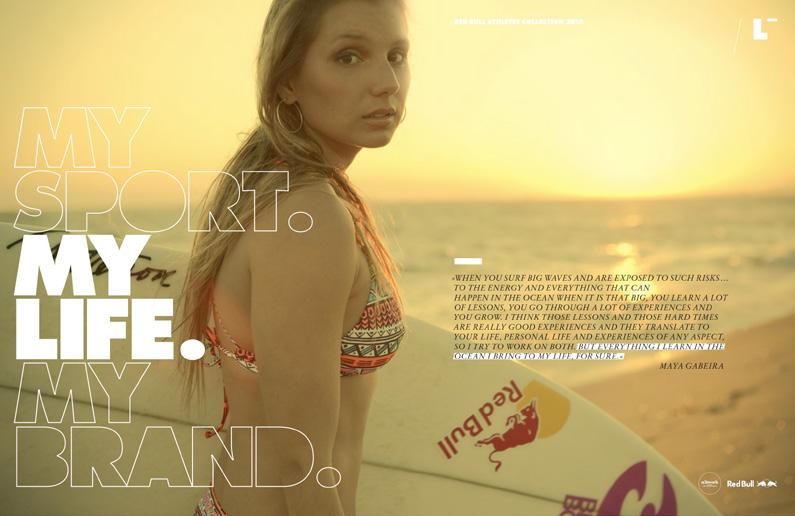
3 minute read
THEY (THE BRANDS) HAVE TO HAVE A CLEAR ANSWER TO THE QUESTION: WHY DO WE EXIST IN THE FIRST PLACE
from 69 — Dennis Hinze
Designing the final products for us is ultimately important because, what I’ll be doing is putting a jacket on a table, or on a person. And with that jacket, I have to be able to show my client, the brand, what will become in the future.
HOW WOULD YOU DESCRIBE CREATIVE DIRECTION?
Advertisement
Creative Direction is “telling a story that people, inside and outside the brand, have to believe in”.
RED BULL ARE ANOTHER MASSIVE CLIENT. ARE YOU EVER DAUNTED BY THE SCALE OF THESE BRANDS?
I presented our concept for the first collection to Dietrich Mateschitz, the owner of Red Bull. While the atmosphere was super nice and the setting was almost private, his aura was super present. Inspiring and maybe a little intimidating.
The Red Bull logo has those two bulls in red, and then the sun in yellow between them. But I didn’t like the yellow, on apparel it seemed cheap to me, so I used a gold sun instead.
In the presentation, Mr. Mateschitz just looked at me, for like a minute or so and didn’t say anything. Then he said, “Do you really think that I will repaint all the planes I own, all the Formula One cars, all the stadiums I’ve built around the world, in gold?”
“Well,” I said, “probably not. But, don’t you like the gold on the styles?” And then he said, “Yeah, it looks great on the polo shirt.” And that was it!
IS SPORT FASHION A SUPER COMPETITIVE MARKET?
In the world of sport fashion there’s so many brands that compete for the same consumer. And in competing for the same consumer, they often times present the same product.
And interestingly, the more complex the sport is, from a technical perspective, the more brands compete in that zone.
In soccer, you have maybe five or six brands. But in outdoor & technical mountaineering, you have 30+ brands competing for the same consumer, using same or similar technologies.
Because of that, the brands have to understand that in order to be seen and liked, they have to present themselves in a context. They have to have a clear answer to the question, ‘why do we exist in the first place?’
So when we go in, we want to understand this question. The North Face was a couple of guys that had a store in California. They were avid mountaineers and they needed products that didn’t exist, so they built their own stuff. They explored products in a new area of activities.
That heritage, of being in California, being climbers, is what you would want to keep hold of. But when The North Face became only fashion, the ‘why’ got lost.
Adidas is a global sports brand, but mostly it’s a soccer brand. They “owned” soccer and they became famous for their black leather soccer shoe with the three white stripes.
While the brand has dramatically evolved from the early days, that team sports DNA is so deeply rooted in the brand, that everything they do must come back to that.
When Adidas entered outdoor sports, some years back, it didn´t really succeed because their products didn’t have the Adidas DNA. And the core consumers said, ‘You’re not a mountaineering brand.’
Now with Adidas, as their new collections feel more ‘team sport’ and different to anything else you will find in the outdoors market, people have a reason to like the brand in that area.

THERE’S A LOT RIDING ON THIS QUESTION OF ‘ WHY ’ A BRAND EXISTS, ISN’T THERE?
There is, but when you answer it correctly, you have the opportunity to become something like Patagonia. Everybody likes Patagonia. Because the ‘why?’ is so strong.
Everything Patagonia does tells you that they have an interest in making the world a better place. They will take whatever old product from you, repair it and give it back to you, because they like the idea that something can exist forever. So that’s the reason for their existence.
Nike’s reason for existence is to make the athlete better. So any solution they create is about making the athlete better.

For Red Bull, I think it’s all about new unexpected experiences. The possibility to do something that was only a dream. One thing that Red Bull does when athletes get signed, they will be asked if there’s anything that they ever dreamed of doing. If they feel it can be achieved safely, the brand will help them realize that dream. Red Bull ‘gives you wings’ really became the DNA of the company.

SO, WHAT DOES THE FUTURE HOLD FOR SPORT FASHION?
Where we come from is that consumers had an interest in a sport product, because it would answer their functional needs: to stay dry, warm, comfortable, safe,…

Today its all about identifying with a brand. Does the product reflect the sport’s culture? Is it relevant for their core audience?
I think the next phase we’re entering is the mindset phase. Right now, we are designing into consumer mindsets more than just sports. Designers and business leaders have to make sure that something we build as product, or decide for the brand, doesn’t hinder the consumer from buying that brand.
For example, if Patagonia did a collaboration with Mercedes, it would harm the brand. Because the mindset of the Patagonia consumer doesn’t see that connection, at all. So they would totally question the brand.
Brands have to become moral leaders and foster a culture of ethical innovation.





